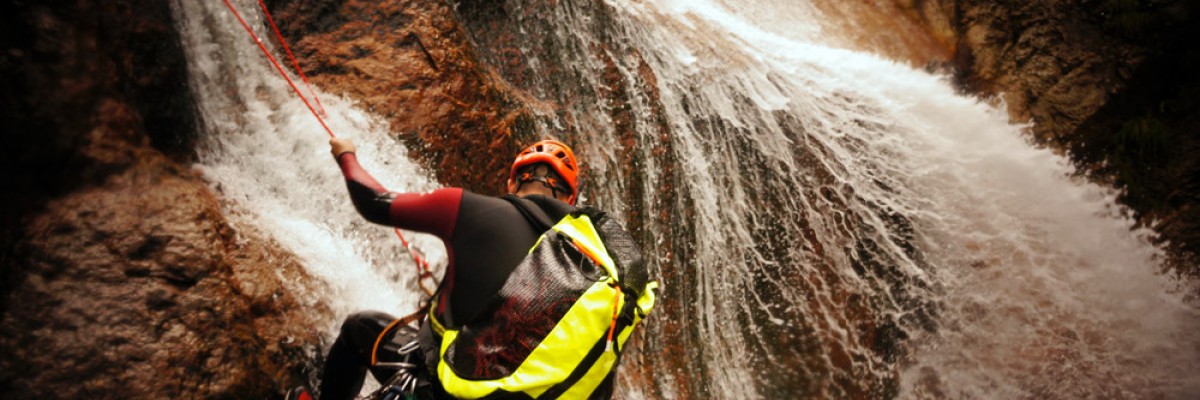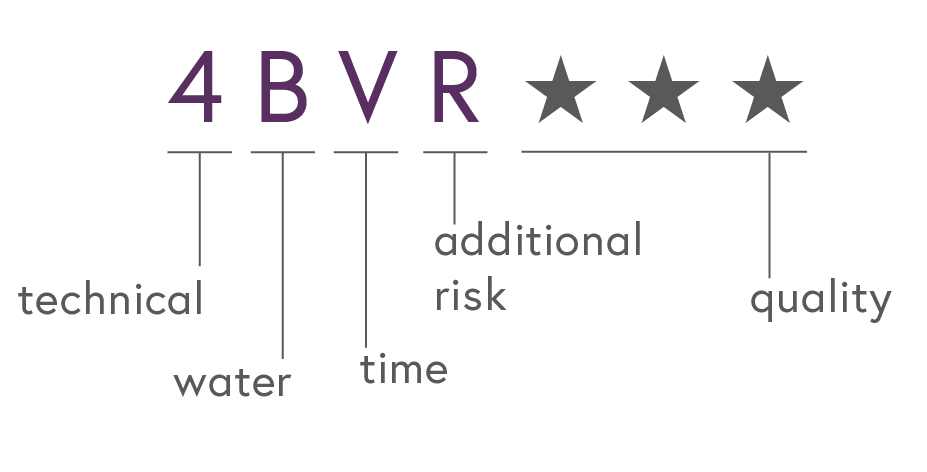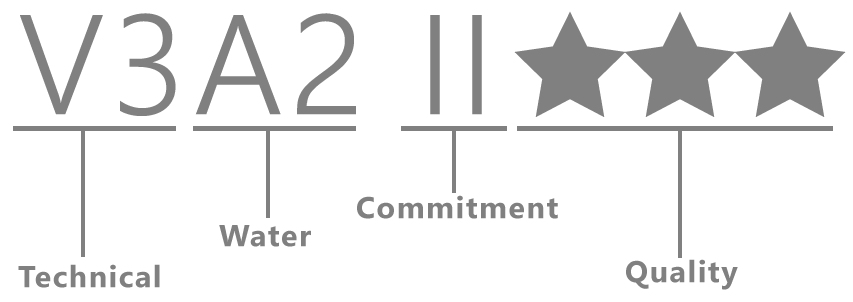
Canyoning rating system
There are a few systems used around the world to rate the difficulty of a canyon but the 2 most widely used base systems are;
1. The American System
2. The French System
Both refer to scales of technical difficulty in terms of ropework/verticality and whitewater. The American system is predominantly used in North America whereas the rest of the world tents to use the French system.
At Canyons we have created a simplified version of the 2 systems from level 1 -6, but the basic progression remains the same.
1. The American System (ACA)

Technical rating
The first number denotes the degree of technical skill (especially rope work) required to complete the canyon successfully.
1: A hike on a path with no special physical obstacles (though navigation may be difficult)
2: Scrambling and/or easy climbing required, but no ropes are necessary. Many groups may want a rope or webbing length for convenience, however
3: Technical canyon requiring ropes and rappelling and/or ascending
4: Extra challenge(s) beyond the obstacles encountered in most class 3 canyons. These may include very long drops, hanging rebelays, unusual exposure, or other difficulties
Water rating
DESCRIPTION
The second letter denotes the type of challenge presented by water in the canyon. (at normal flows)
A: Normally dry or very little water. Dry falls. Water, if present, can be avoided and/or is very shallow. Shoes may get wet, but no wetsuit or drysuit required.
B: Normally has water with no current or very light current. Still pools. Falls normally dry or running at a trickle. Expect to do some deep wading and/or swimming. Wetsuit or drysuit may be required depending on water and air temperatures.
C: Normally has water with current. Waterfalls. Expect to do some deep wading and/or swimming in current. Wetsuit or drysuit may be required depending on water and air temperatures. Class C canyons may be rated more precisely using the following system:
C1: Normally has water with light to moderate current. Easy water hazards.
C2: Normally has water with strong current. Water hazards like hydraulics and siphons require advanced skills and special care.
C3: Normally has water with very strong current. Dangerous water hazards. Experts only.
C4: Extreme problems and hazards will be difficult to overcome, even for experienced experts with strong swimming skills.
Time rating
The roman numerals denotes approximately how long the entire canyon trip generally takes a typical group (2-4 people) to complete.
I: A few hours [<2h]
II: Around half a day [2h-4h]
III: Most of a day [4h-8h]
IV: A full day with a prompt start [>8h]
V: More than one day
VI: Many days; an expedition
Extra information
Some beta authors will append a movie-style R or X indicating that extraordinary risks of different degrees exist in the canyon. Also, some ratings will also include a rating for the difficulty of climbing required by the canyon in the Yosemite Decimal form (5.11a, for instance)
The allowed values for this property are:
(blank): No extraordinary risk
R: Risky, not recommended for beginners
X (or R+): Extreme, only for experts
Quality
Quality ratings, of course, are very subjective. I use a 0 to 3 star system:
★★★ - A Classic. Really good.
★★ - Pretty Good, well worth doing.
★ - Has redeeming qualities. (0 stars) Probably not worth the bother.
2. The French System

Assumptions
The gradings here assume the following;
An average water flow for the usual season that particular canyon is descended.
A group of 5 people, who have not been in the canyon before, but have suitable experience and skills to descend the canyon.
The level of difficulty is set by at least one of the situations in the table being found in the canyon.
The jumps are considered optional
Vertical rating
The number following the 'v' in the French rating denotes the degree of technical skill (especially rope work) required to complete the canyon successfully.
v1: Rope normally unnecessary for progress. No climbing or down-climbing.
v2: Easy rappels up to 10m (30ft). Easy climbing or down-climbing with little exposure.
v3: Simple rappels up 30m (100ft) in weak water flow. Potentially tricky hand-line traverses and down-climbs.
v4: Big rappels of more than 30m (100ft) in weak to moderate flow. Bottom of rappel out of sight or in turbulent pools. Simple multi-stage rappels. Moderate risk of getting ropes stuck. Exposed climbs.
v5: Difficult rappels in moderate to strong water flow. Multi-stage rappels with hanging stations or redirects. Rope recovery difficult. Difficult and/or exposed climbs.
v6: Very difficult rappels in very strong water flow with possible hydraulics or siphons at the bottom. Awkward rappels stations, difficult traverses, exposed and difficult climbs.
v7: Extremely difficult rappels in very strong water flow with powerful hydraulics or siphons at the bottom. Extremely difficult or risky climbs.
Aquatic rating
The number following the 'a' in the French rating denotes the type of challenge presented by water in the canyon.
a1: Dry or walking in calm water that will require no mandatory swims, jumps or slides.
a2: Calm water. It may require swims of up to 10m (30ft), jumps of up to 3m (10ft) or easy toboggans.
a3: Weak current. It may require swims of up to 30m (100ft), jumps of up to 5m (15ft) or moderate toboggans.
a4: Moderate current. It may require prolonged immersion in water, jumps of up to 8m (25ft), long and steep toboggans or easy siphons up to 1m (3ft).
a5: Strong current with avoidable water hazards. It may require prolonged immersion in cold water, jumps of up to 10m (30ft), technical jumps up to 8m or easy siphons up to 2m (6ft).
a6: Very strong current with unavoidable water hazards. It may require jumps of up to 14m (45ft), technical jumps up to 8m or easy siphons up to 2m (6ft).
a7: Extremely dangerous water hazards that will be difficult to overcome. It may require jumps over 14m (45ft), technical jumps over 10m (30ft) or technical siphons with strong current or poor visibility.
Commitment/Duration rating
The roman numerals in the French rating indicates commitment/duration. Duration is approximately how long it will take the entire canyon trip for a typical group to complete. Commitment is used to distinguish what canyons can be easily escaped in case of flood or medical emergency. Most books and websites use this numeral to indicate commitment level ONLY, while specifying separately the duration for approach, descent and exit in hours/minutes.
I: A few hours [<2h]. Ability to escape flash flood easily and quickly. Easy exits present in all portions of the route.
II: Around half a day [2h-4h]. Ability to escape flash flood in ¼ hour. Escapes no more than ½ hour apart.
III: Most of a day [4h-8h]. Ability to escape flash flood in ¾ hour. Escapes no more than 1 hour apart.
IV: A full day with a prompt start [>8h]. Ability to escape flash flood in 1 hour. Escapes no more than 2 hours apart.
V: Between one and two days. Ability to escape flash flood in 2 hours. Escapes no more than 4 hours apart.
VI: More than 2 days; an expedition. Ability to escape flash flood takes over 2 hours. Escapes are more than 4 hours apart.
Quality
An optional star system indicates the quality/beauty/fun factor of a canyon. 0 stars through to 4 stars.